
RAAF Station Archerfield was a permanent Royal Australian Air Force station at Archerfield Airport in Brisbane, Queensland, Australia, from 1939 to 1956.
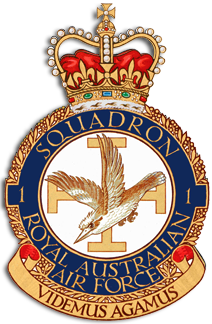
No. 1 Squadron is a Royal Australian Air Force (RAAF) squadron headquartered at RAAF Base Amberley, Queensland. It is controlled by No. 82 Wing, part of Air Combat Group, and is equipped with Boeing F/A-18F Super Hornet multi-role fighters.
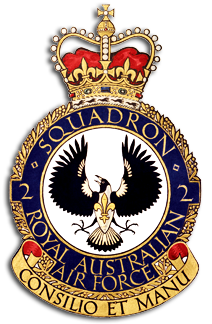
No. 2 Squadron is a Royal Australian Air Force (RAAF) squadron that operates from RAAF Base Williamtown, near Newcastle, New South Wales. From its formation in 1916 as part of the Australian Flying Corps, it has flown a variety of aircraft types including fighters, bombers, and Airborne Early Warning & Control (AEW&C). During World War I, the squadron operated on the Western Front conducting fighter sweeps and ground-attack missions. It was disbanded in mid-1919, following the end of hostilities. The squadron was briefly re-raised in 1922 as part of the newly independent RAAF, but was disbanded after only a couple of months and not reformed until 1937. It saw action as a bomber unit in the South West Pacific theatre of World War II and, equipped with English Electric Canberra jets, in the Malayan Emergency and the Vietnam War. The squadron was again disbanded in 1982, following the retirement of the Canberra. It was re-formed in 2000 to operate the Boeing 737 AEW&C "Wedgetail". One of the six Boeing 737s was deployed to the Middle East in September 2014, as part of Australia's contribution to the military coalition against ISIS.

No. 6 Squadron is a Royal Australian Air Force (RAAF) electronic attack squadron. It was formed in 1917 as a training unit based in England during World War I. The squadron was disbanded in 1919 but re-formed at the start of 1939. It subsequently saw combat as a light bomber and maritime patrol squadron during World War II, and took part in the New Guinea Campaign and New Britain Campaign before being disbanded after the war.

No. 12 Squadron was a Royal Australian Air Force (RAAF) general purpose, bomber and transport squadron. The squadron was formed in 1939 and saw combat in the South West Pacific theatre of World War II. From 1941 to 1943, it mainly conducted maritime patrols off northern Australia. The squadron was based at Merauke in western New Guinea from November 1943 to July 1944, when it was withdrawn from operations. After being re-equipped, it operated as a heavy bomber unit from February 1945 until the end of the war. The squadron continued in this role until it was redesignated No. 1 Squadron RAAF in February 1948. The squadron was reformed in 1973 to operate transport helicopters but was again disbanded in 1989.
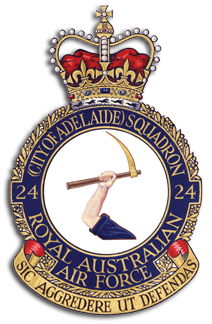
No. 24 Squadron is a Royal Australian Air Force squadron. The squadron was formed in 1940 and saw action as a bomber squadron during World War II serving in the Pacific theatre against the Japanese, and undertaking operations during the Battle of Rabaul, and the New Guinea, New Britain and Borneo campaigns. The squadron was disbanded in 1946 following the conclusion of hostilities, but was re-formed in 1951. From then until 2010 the squadron was an RAAF Reserve squadron located near Adelaide, South Australia; for part of this time, until 1960, the squadron continued to perform flying duties, before converting to a ground support role. In 2010, the squadron combined with Combat Support Unit Edinburgh to become a Permanent Air Force unit and it currently forms part of No. 96 Wing, Combat Support Group.

No. 102 Squadron was a Royal Australian Air Force (RAAF) heavy bomber squadron of World War II. The squadron was only active for less than nine months before being disbanded. No. 102 Squadron was formed at Cecil Plains, Queensland on 31 May 1945. The Squadron's B-24 Liberator bombers arrived in July. While the Squadron began training on these aircraft, the war ended before it reached operational status. Following the end of the war the squadron operated in the transport role until December 1945. No. 102 Squadron was disbanded on 19 March 1946.
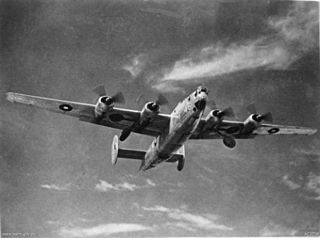
No. 99 Squadron was a Royal Australian Air Force (RAAF) heavy bomber squadron that was raised during World War II. Formed late in the war, the squadron ultimately did not see action as it became combat ready just as the war came to an end. After the war, it undertook general transportation duties before being disbanded in mid-1946.

No. 82 Wing is the strike and reconnaissance wing of the Royal Australian Air Force (RAAF). It is headquartered at RAAF Base Amberley, Queensland. Coming under the control of Air Combat Group, the wing operates F/A-18F Super Hornet multirole fighters, EA-18G Growler electronic warfare aircraft, and Pilatus PC-21 forward air control aircraft. Its units include Nos. 1 and 6 Squadrons, operating the Super Hornet and Growler respectively, as well as No. 4 Squadron, operating the PC-21.

No. 21 Squadron RAAF is a Royal Australian Air Force (RAAF) general reserve squadron. Formed in the mid-1930s as a unit of the part-time Citizen Air Force (CAF), it was mobilised for service during World War II, when it saw action against the Japanese as a fighter unit in the Malayan campaign, a dive bomber unit in the New Guinea campaign, and a heavy bomber unit in the Borneo campaign. After the war, the squadron continued to fly until 1960, when the CAF ceased flying operations. At that time, No. 21 Squadron converted to a non-flying support role, which it currently fulfils at RAAF Base Point Cook and RAAF Williams - Laverton.

No. 22 Squadron is a Royal Australian Air Force (RAAF) mixed Permanent and Reserve squadron that provides support for the RAAF in the Sydney region. Formed in 1936, the squadron served in Papua New Guinea during the Second World War, and later followed the Pacific War as far as the Philippines. Following the war, the squadron was re-formed in 1948 but was converted to a non-flying support role in mid-1960. It is currently based at RAAF Base Richmond, New South Wales.
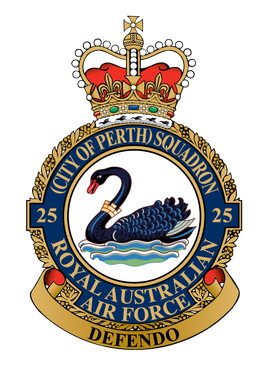
No. 25 Squadron is a general reserve squadron of the Royal Australian Air Force (RAAF). It is based at RAAF Base Pearce in Perth, Western Australia, and forms part of the Combat Support Group. The squadron was formed in early 1937 and until early 1939 was designated as No. 23 Squadron. During World War II, it provided local air defence for the Perth region, before undertaking Army co-operation duties in 1943–1944 and then converting to a heavy bomber role in 1945. Flying B-24 Liberators, the squadron took part in operations against Japanese targets in the Netherlands East Indies (NEI) and supported Allied ground operations during the Borneo Campaign.

No. 35 Squadron is a Royal Australian Air Force (RAAF) transport unit. Formed in 1942, No. 35 Squadron operated during World War II, transporting cargo and passengers around Australia, New Guinea and the Netherlands East Indies, equipped with a variety of aircraft including the Douglas Dakota. It was disbanded after the war, but was re-raised in the 1960s for service during the Vietnam War, flying transportation and resupply operations with DHC-4 Caribous in support of Australian and US forces. The squadron was subsequently augmented with rotary-wing aircraft, operating UH-1 Iroquois in both the transportation and gunship roles. In the late 1980s, the squadron returned to a solely fixed-wing transport role. It ceased operations in 2000, but was re-raised in January 2013. It began re-equipping with C-27 Spartan transports in 2015.

Eastern Area Command was one of several geographically based commands raised by the Royal Australian Air Force (RAAF) during World War II. It was formed in May 1942, and controlled units located in New South Wales and southern Queensland. Headquartered in Sydney, Eastern Area Command's responsibilities included air defence, aerial reconnaissance and protection of the sea lanes within its boundaries. Its flying units operated fighters, reconnaissance bombers, and dive bombers, and concentrated on convoy escort, maritime patrol and anti-submarine warfare. The size of the area was such that the RAAF twice considered splitting it, but nothing came of this.

No. 3 Aircraft Depot was a maintenance unit of the Royal Australian Air Force (RAAF). Formed in March 1942 at RAAF Station Amberley, Queensland, its prime function initially was the assembly and despatch of combat aircraft from the United States; it also performed salvage operations. From 1942 until 1947 it took on the role of administering the Amberley base. The depot was responsible for heavy maintenance of the RAAF's English Electric Canberra jet bombers following their entry into service in 1953. In the 1970s it began maintaining and upgrading the General Dynamics F-111C swing-wing bomber, along with Bell UH-1 Iroquois and Boeing CH-47 Chinook helicopters. No. 3 AD merged with No. 482 Maintenance Squadron in March 1992 to form No. 501 Wing, which maintained the F-111 until disbanding in 2001.

No. 1 Aircraft Depot (No. 1 AD) was a maintenance unit of the Royal Australian Air Force (RAAF). Formed in July 1921 at RAAF Point Cook, Victoria, it relocated to the nearby RAAF Laverton in March 1926. As well as servicing aircraft and other equipment, in its early years the depot supported survey flights in Australia and the Pacific region. It was also responsible for training maintenance staff.
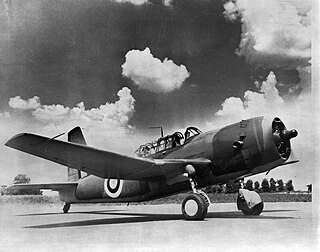
721 Naval Air Squadron was a Naval Air Squadron of the Royal Navy's Fleet Air Arm (FAA). 721 Naval Air Squadron formed at HMS Gadwall, RNAS Belfast, Northern Ireland, at the beginning of March 1945, as a Fleet Requirements Unit for the British Pacific Fleet. Initially equipped with Vultee Vengeance target tugs, it arrived at HMS Nabaron, RNAS Ponam, Admiralty Islands in May 1945, and commenced operations towing targets. The squadron moved to HMS Nabsford, RNAMY Archerfield, Brisbane, Australia, during October and then relocated to Hong Kong at the beginning of 1946, moving to HMS Nabcatcher, RNAS Kai Tak, where it eventually disbanded at the end of 1947.

Western Area Command was one of several geographically based commands raised by the Royal Australian Air Force (RAAF) during World War II. It was formed in January 1941, and controlled RAAF units located in Western Australia. Headquartered in Perth, Western Area Command was responsible for air defence, aerial reconnaissance and protection of the sea lanes within its boundaries. Its aircraft conducted anti-submarine operations throughout the war, and attacked targets in the Dutch East Indies during the Borneo campaign in 1945.

North-Western Area Command was one of several geographically based commands raised by the Royal Australian Air Force (RAAF) during World War II. Its wartime sphere of operations included the Northern Territory, adjacent portions of Queensland and Western Australia, and the Dutch East Indies. The command was formed in January 1942, following the outbreak of the Pacific War, from the western part of Northern Area Command, which had covered all of northern Australia and Papua. Headquartered at Darwin, North-Western Area Command was initially responsible for air defence, aerial reconnaissance and protection of the sea lanes within its boundaries.
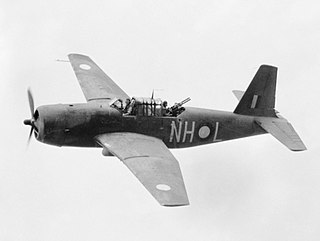
The Royal Australian Air Force (RAAF) operated Vultee Vengeance dive bombers during World War II. The Australian Government ordered 297 of the type in late 1941 as part of efforts to expand the RAAF. This order was later increased to 400 aircraft. A few Vengeances arrived in Australia during 1942, and large-scale deliveries commenced in early 1943; further orders were cancelled in 1944 after 342 had been delivered.




















